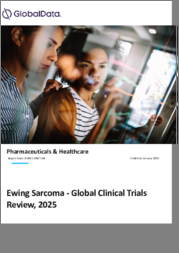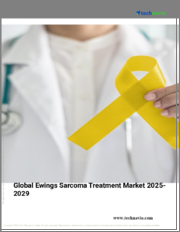
|
시장보고서
상품코드
1819722
유잉육종 시장 - 세계 및 지역별 분석 : 지역별 - 분석과 예측(2025-2035년)Ewing Sarcoma Market - A Global and Regional Analysis: Focus on Country and Region - Analysis and Forecast, 2025-2035 |
||||||
세계 유잉육종 시장 - 분석 및 예측(2025-2035)
유잉육종은 희귀한 침습성 뼈 및 연부조직암으로 주로 소아, 청소년, 청년, 젊은 성인에게 발생합니다.
특정 유전자 전좌가 특징이며, 특히 EWSR1-FLI1 융합 유전자가 종양의 성장을 촉진합니다. 임상적으로 유잉육종은 주로 장골, 골반, 흉벽에 발생하며, 전형적으로 통증과 국소 부종을 동반합니다. 표준 치료는 국소 및 전신 제어를 달성하기 위해 화학요법, 수술요법, 방사선 요법을 결합한 집중적인 다약제 병용요법을 시행합니다.
유잉육종 시장의 주요 촉진요인 중 하나는 유잉육종 유병률의 증가입니다. 유잉육종은 드문 암으로 여겨지지만, 그 발생률은 특히 특정 지역과 연령층에서 점차 증가하고 있습니다. 이러한 유병률의 증가는 임상 및 연구의 주목을 받고 있으며, 고급 치료 옵션을 필요로 하는 환자 수를 증가시키고 있습니다. 진단 사례의 증가는 보다 효과적인 치료법에 대한 미충족 수요의 시급성을 강조할 뿐만 아니라, 제약회사와 진단 개발 회사들이 새로운 접근 방식에 투자하는 비즈니스 사례를 뒷받침하고 있습니다. 인지도가 높아짐에 따라 더 많은 환자들이 조기에 발견되고, 표적 치료와 전문적 치료에 대한 수요가 더욱 증가하고 있습니다.
또한, 전 세계 의료비 지출 증가는 유잉육종 시장의 성장을 촉진하는 주요 요인으로 작용하고 있습니다. 의료 예산의 증가로 암 연구에 대한 자금 지원이 확대되고, 첨단 진단 및 치료 시설에 대한 접근성이 향상되고, 종합적인 암 치료 프로그램이 광범위하게 시행되고 있습니다. 또한, 의료비 증가는 유잉육종과 같은 희귀질환이 국가 암 치료 계획에 포함될 수 있도록 지원하며, 더 나은 상환 체계와 첨단 치료법에 대한 환자 접근성을 향상시킬 수 있습니다. 이러한 재정적 지원은 궁극적으로 제약회사들의 유잉육종에 대한 혁신적인 치료제 개발 및 상용화를 촉진하고 시장 개척을 가속화하고 있습니다.
그러나 유잉육종 시장의 유망한 성장에도 불구하고 몇 가지 과제도 존재합니다. 주요 관심사 중 하나는 유잉육종의 치료비가 비싸다는 것입니다. 유잉육종 치료는 일반적으로 집중적인 화학요법, 수술, 방사선 요법을 병행하며, 이 모든 것이 매우 높은 총비용의 원인이 됩니다. 또한, 전용 종양센터에서의 전문적인 치료, 장기간의 입원, 부작용과 합병증을 관리하기 위한 고가의 지지요법이 필요하기 때문에 비용은 더욱 증가하게 됩니다. 이러한 높은 비용은 환자와 의료 시스템에 큰 경제적 장벽이 되고, 특히 중저소득 지역에서는 첨단 치료에 대한 접근성을 제한하는 요인으로 작용할 수 있습니다. 또한, 부유한 시장이라 할지라도 보험 적용의 격차나 본인 부담금은 환자가 최적의 치료 요법을 받으려는 의욕을 떨어뜨려 궁극적으로 시장 성장에 영향을 미칠 수 있습니다.
세계 유잉육종 시장은 경쟁이 치열하며, Salarius Pharmaceuticals, Eli Lilly and Company, Pfizer, Inc, BioAtla Inc 등 주요 기업들이 기술 혁신과 시장 성장을 주도하고 있습니다. 이들 기업은 내성 극복과 진행 및 전이 환자의 생존율 향상을 위한 저분자 억제제, 면역치료제 등 신규 표적 치료제 개발에 많은 투자를 하고 있습니다. 또한, 조기 진단과 전문적인 치료 접근성을 개선하기 위해 각 지역에서의 라이선스 계약 및 교육 활동을 통해 전 세계적으로 범위를 넓혀가고 있습니다. 이러한 복합적인 노력을 통해 각 회사는 파이프라인을 차별화하고, 과학적 신뢰성을 확립하고, 고도로 전문화된 암 분야에서 시장 점유율을 확보할 수 있었습니다.
시장 세분화
세분화 1 : 지역별
- 북미
- 유럽
- 아시아태평양
또한, 첨단 영상 진단, 분자유전학적 검사, 액체 생검 기술 등 진단 도구의 눈부신 기술 발전으로 유잉육종의 발견과 관리 방법이 크게 변화하고 있습니다. 보다 정확한 조기 진단을 통해 적시에 개입할 수 있으며, 이는 유잉육종과 같은 침습성 암 환자의 예후를 개선하는 데 있어 매우 중요합니다. 또한, 정밀 진단은 특정 유전자 전좌(예 : EWSR1-FLI1)를 식별하는 데 도움이 되며, 보다 타겟화된 치료 전략과 임상시험에서 더 나은 환자 계층화를 가능하게 합니다. 이러한 발전은 생존율을 향상시킬 뿐만 아니라 새로운 진단 제품 및 관련 서비스에 대한 수요를 촉진하고 전체 시장의 성장을 뒷받침하고 있습니다.
목차
주요 요약
제1장 세계의 유잉육종 시장 : 업계 분석
- 시장 개요와 생태계
- 역학적 분석
- 주요 시장 동향
- 영향 분석
- 규제 상황
- 파이프라인 분석
- 시장 역학
- 개요
- 시장 성장 촉진요인
- 시장 성장 억제요인
- 시장 기회
제2장 세계의 유잉육종 시장(지역별), 금액, 2023-2035년
- 북미
- 유럽
- 아시아태평양
제3장 경쟁 구도와 기업 개요
- 경쟁 구도
- 기업 개요
- Salarius Pharmaceuticals.
- Jazz Pharmaceuticals and PharmaMar
- Eli Lilly and Company
- Pfizer, Inc.
- BioAtla Inc.
- F. Hoffmann-La Roche Ltd.
- Cellectar Biosciences
- Sumitomo Pharma Oncology.
- Inhibrx
- 기타
제4장 조사 방법
KSM 25.09.29Global Ewing Sarcoma Market, Analysis and Forecast: 2025-2035
Ewing sarcoma is a rare and aggressive form of bone and soft tissue cancer that primarily affects children, adolescents, and young adults, most commonly between the ages of 10 and 20. It is characterized by specific genetic translocations, most notably the EWSR1-FLI1 fusion gene, which drives tumor growth. Clinically, Ewing sarcoma often arises in the long bones, pelvis, or chest wall and is typically associated with pain and localized swelling; it may also metastasize early, especially to the lungs and other bones, which significantly impacts prognosis. Standard treatment involves an intensive multimodal approach that combines chemotherapy, surgery, and/or radiotherapy to achieve local and systemic control.
One of the major drivers of the Ewing sarcoma market is the increasing prevalence of Ewing sarcoma. Although Ewing sarcoma is considered a rare cancer, its incidence has shown a gradual increase, particularly in certain regions and age groups. This rise in prevalence is drawing greater clinical and research attention, creating a larger pool of patients who require advanced treatment options. The increasing number of diagnosed cases not only highlights an urgent unmet need for more effective therapies but also supports the business case for pharmaceutical companies and diagnostic developers to invest in novel approaches. As awareness grows, more patients are being identified earlier, further driving demand for targeted treatments and specialized care.
Additionally, the overall rise in healthcare spending globally is a major enabler for growth in the Ewing sarcoma market. Increased healthcare budgets allow for better funding of cancer research, improved access to advanced diagnostic and treatment facilities, and wider implementation of comprehensive cancer care programs. Higher spending also supports the inclusion of rare diseases such as Ewing sarcoma in national cancer plans, leading to better reimbursement frameworks and greater patient access to cutting-edge therapies. This financial support ultimately encourages pharmaceutical companies to develop and commercialize innovative treatments for Ewing sarcoma, accelerating market expansion.
However, despite the promising growth of the Ewing sarcoma market, several challenges exist. One of the primary concerns is the high cost of the treatment of Ewing sarcoma. The treatment of Ewing sarcoma typically involves a combination of intensive chemotherapy, surgery, and radiation therapy, all of which contribute to very high overall costs. The expenses are further elevated by the need for specialized care in dedicated oncology centers, prolonged hospital stays, and costly supportive treatments to manage side effects and complications. For patients and healthcare systems, these high costs can create significant financial barriers, limiting access to advanced therapies, especially in low- and middle-income regions. Additionally, even in wealthier markets, insurance coverage gaps and out-of-pocket expenses can discourage patients from pursuing or completing optimal treatment regimens, ultimately affecting market growth.
The global Ewing sarcoma market is highly competitive, with several leading companies driving innovation and market growth, such as Salarius
Pharmaceuticals, Eli Lilly and Company, Pfizer, Inc., and BioAtla Inc. These companies are heavily investing in the development of novel targeted therapies, including small-molecule inhibitors and immunotherapies designed to overcome resistance and improve survival in advanced or metastatic cases. Additionally, companies are expanding their global reach through regional licensing agreements and awareness initiatives to improve early diagnosis and access to specialized care. These combined efforts allow them to differentiate their pipelines, build scientific credibility, and capture market share in this highly specialized oncology segment.
Market Segmentation:
Segmentation 1: by Region
- North America
- Europe
- Asia-Pacific
Furthermore, significant technological progress in diagnostic tools such as advanced imaging modalities, molecular genetic testing, and liquid biopsy techniques is transforming how Ewing sarcoma is detected and managed. Early and more accurate diagnosis enables timely intervention, which is critical in improving patient outcomes for aggressive cancers such as Ewing sarcoma. Additionally, precision diagnostics help identify specific genetic translocations (such as EWSR1-FLI1), allowing for more targeted therapeutic strategies and better patient stratification in clinical trials. These advancements not only improve survival rates but also drive demand for new diagnostic products and related services, supporting overall market growth.
Table of Contents
Executive Summary
Scope and Definition
Market/Product Definition
Inclusion and Exclusion
Key Questions Answered
Analysis and Forecast Note
1. Global Ewing Sarcoma Market: Industry Analysis
- 1.1 Market Overview and Ecosystem
- 1.2 Epidemiological Analysis
- 1.3 Key Market Trends
- 1.3.1 Impact Analysis
- 1.4 Regulatory Landscape
- 1.5 Pipeline Analysis
- 1.6 Market Dynamics
- 1.6.1 Overview
- 1.6.2 Market Drivers
- 1.6.3 Market Restraints
- 1.6.4 Market Opportunities
2. Global Ewing Sarcoma Market (by Region), Value ($Million), 2023-2035
- 2.1 North America
- 2.1.1 Market Dynamics
- 2.1.2 Market Sizing and Forecast
- 2.1.3 North America Ewing Sarcoma Market, by Country ($Million), 2023-2035
- 2.1.3.1 U.S.
- 2.2 Europe
- 2.2.1 Market Dynamics
- 2.2.2 Market Sizing and Forecast
- 2.2.3 Europe Ewing Sarcoma Market, by Country ($Million), 2023-2035
- 2.2.3.1 U.K.
- 2.2.3.2 France
- 2.2.3.3 Germany
- 2.2.3.4 Italy
- 2.2.3.5 Spain
- 2.3 Asia-Pacific
- 2.3.1 Market Dynamics
- 2.3.2 Market Sizing and Forecast
- 2.3.3 Asia-Pacific Ewing Sarcoma Market, by Country ($Million), 2023-2035
- 2.3.3.1 Japan
3. Competitive Landscape and Company Profiles
- 3.1 Competitive Landscape
- 3.1.1 Mergers and Acquisitions
- 3.1.2 Partnership, Alliances and Business Expansion
- 3.1.3 New Offerings
- 3.1.4 Regulatory Activities
- 3.1.5 Funding Activities
- 3.2 Company Profiles
- 3.2.1 Salarius Pharmaceuticals.
- 3.2.1.1 Overview
- 3.2.1.2 Top Products / Product Portfolio
- 3.2.1.3 Top Competitors
- 3.2.1.4 Target Customers/End-Users
- 3.2.1.5 Key Personnel
- 3.2.1.6 Analyst View
- 3.2.2 Jazz Pharmaceuticals and PharmaMar
- 3.2.2.1 Overview
- 3.2.2.2 Top Products / Product Portfolio
- 3.2.2.3 Top Competitors
- 3.2.2.4 Target Customers/End-Users
- 3.2.2.5 Key Personnel
- 3.2.2.6 Analyst View
- 3.2.3 Eli Lilly and Company
- 3.2.3.1 Overview
- 3.2.3.2 Top Products / Product Portfolio
- 3.2.3.3 Top Competitors
- 3.2.3.4 Target Customers/End-Users
- 3.2.3.5 Key Personnel
- 3.2.3.6 Analyst View
- 3.2.4 Pfizer, Inc.
- 3.2.4.1 Overview
- 3.2.4.2 Top Products / Product Portfolio
- 3.2.4.3 Top Competitors
- 3.2.4.4 Target Customers/End-Users
- 3.2.4.5 Key Personnel
- 3.2.4.6 Analyst View
- 3.2.5 BioAtla Inc.
- 3.2.5.1 Overview
- 3.2.5.2 Top Products / Product Portfolio
- 3.2.5.3 Top Competitors
- 3.2.5.4 Target Customers/End-Users
- 3.2.5.5 Key Personnel
- 3.2.5.6 Analyst View
- 3.2.6 F. Hoffmann-La Roche Ltd.
- 3.2.6.1 Overview
- 3.2.6.2 Top Products / Product Portfolio
- 3.2.6.3 Top Competitors
- 3.2.6.4 Target Customers/End-Users
- 3.2.6.5 Key Personnel
- 3.2.6.6 Analyst View
- 3.2.7 Cellectar Biosciences
- 3.2.7.1 Overview
- 3.2.7.2 Top Products / Product Portfolio
- 3.2.7.3 Top Competitors
- 3.2.7.4 Target Customers/End-Users
- 3.2.7.5 Key Personnel
- 3.2.7.6 Analyst View
- 3.2.8 Sumitomo Pharma Oncology.
- 3.2.8.1 Overview
- 3.2.8.2 Top Products / Product Portfolio
- 3.2.8.3 Top Competitors
- 3.2.8.4 Target Customers/End-Users
- 3.2.8.5 Key Personnel
- 3.2.8.6 Analyst View
- 3.2.9 Inhibrx
- 3.2.9.1 Overview
- 3.2.9.2 Top Products / Product Portfolio
- 3.2.9.3 Top Competitors
- 3.2.9.4 Target Customers/End-Users
- 3.2.9.5 Key Personnel
- 3.2.9.6 Analyst View
- 3.2.10 Others
- 3.2.1 Salarius Pharmaceuticals.













